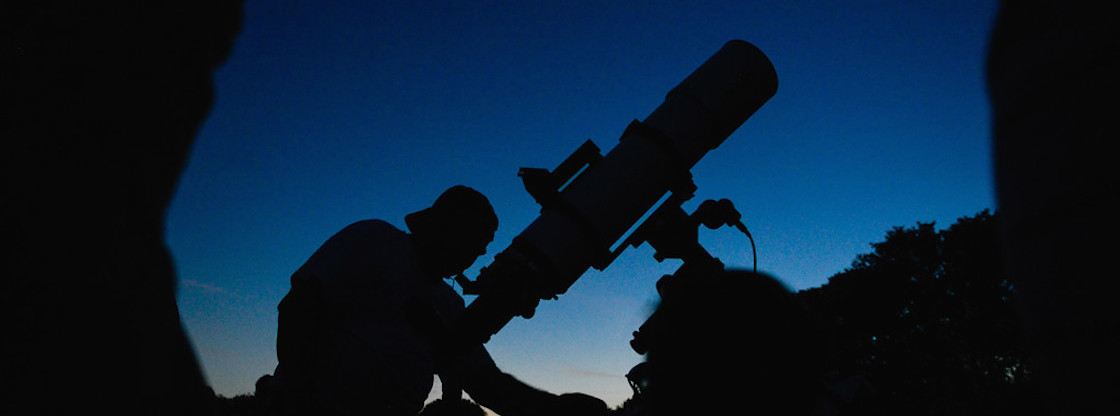Adler’s Guide To Viewing The Universe

Launching into astronomy, especially sky watching, can be a significant investment in time and money. The entry point for telescopes is usually several hundred dollars, but for that price you can acquire an instrument that will last a lifetime.
Keep in mind that there is no “perfect” decision when buying astronomical equipment. Everything is always a compromise between what views you can obtain versus how much money you are willing to spend. There are advantages and disadvantages to every piece of equipment you buy.
This guide will help you make the foray into what will hopefully be a lifelong passion for our skies and what lies beyond them.
First Steps
Try Before You Buy
A lot of us get our start without buying a telescope, but using what is in the house. You can see the Moon and the moons of Jupiter with a good pair of 10x binoculars—they will be easier to use if you mount them on an ordinary camera tripod using a binocular bracket (which can be picked up at a local camera store). Some people are exclusively binocular observers and there are long lists of things to see. If you buy binoculars for this purpose, then we recommend at least 10×50.
If you have a small spotting scope (20x) then you can see Jupiter, Saturn’s rings, the Moon and a few star clusters and brighter nebulae (like the Orion nebula and the Andromeda Galaxy). You can see actually see a lot (as much as Galileo did with his first telescope, which was a lot poorer instrument than modern spotting ‘scopes).
Used Or New?
You can often buy a used scope cheaper than you can buy a new one.
People in this hobby are constantly upgrading their telescopes, and so are always selling their old equipment to pay for new equipment. As a general rule, stargazers tend to take good care of their equipment so most of it will be in pretty good shape.
Some people troll Craigslist, but we recommend checking out the classifieds at Astromart.
What To Look For
The most critical properties of telescopes are stability and aperture. Stability means a mount that doesn’t shake—shaky mounts (like most tripod mounted telescopes you see) are hard to point, and the images they produce are generally poor. You can make shaky mounts more stable, but they are often more of a nuisance than they are worth; non-shaky tripods are easy to find, but cost a premium price.
Aperture is the diameter of the telescope, and is what affects what you can see. A large aperture allows you to see dimmer objects, and also see objects with better resolution. The general rule of thumb is the useful magnification of a telescope is about 30-40x per inch of aperture. You’ll often see small telescopes for sale that claim to be good up to 400x! This is false—you’ll never get a good view at that power with such a small telescope so it’s best to steer clear.
What To Buy?
Deciding WHAT telescope to buy is the hardest part about getting started. Trying lots of telescopes beforehand will teach you want you like to look through. The usual rule is to start with something you can easily pull outside and setup in just a few minutes—the more hassle it is to set up your telescope, the less likely you will be to use it!
Check out the Adler’s online store for some telescope options for purchase.
If you are going to just look at the Moon and maybe a few planets, then almost any telescope should do. However, if you want to see faint things, like galaxies and nebulae, then reflectors are recommended because they gather more light. See section below regarding reflectors.
Accessories
Every investment in telescopes also has a hidden investment in accessories needed to make the whole game work. You should generally budget for this as well.
Eye Pieces
You’ll need a good set of eyepieces for each ‘scope. As a general rule, people only tend to use 2 or 3, so you you won’t need a lot of options. For most ‘scopes, something in the 20mm-25mm range will be good for normal sky viewing; if you add a 7-10mm range for higher magnifications then you’ll see even more. You can spend as much money on eyepieces as you have to spend, but for casual observing spending a lot isn’t necessary. Some Adler astronomers are fans of the Plossl designs; Orion has a nice series called “SIRIUS”, with eyepieces in the $60 range.
Many ‘scopes come packaged with a good starter set of eyepieces. You can always add more, or purchase eyepiece accessories (like Barlow lenses) later.
Filters
If you have a lot of light pollution, you may find it useful to have filters for your eyepieces, depending on what you’re observing. The Moon and planets will be fine without filters, but if you look at fainter nebulae or galaxies, you might consider purchasing a filter. We’d recommend either an UltraHigh Contrast, or a Light Pollution filter. These simply thread on to the back of your eyepieces before you set them in the ‘scope. They likely won’t help tremendously with galaxies and star clusters (though they will some), but should make a big difference on nebulae.
Note that the only true cure for light pollution is to go to dark skies—take your telescope camping! A light pollution filter will help, but unfortunately it will not completely counter the effects of living under city lights.
I find a neutral density moon filter is also a must: if you plan on doing daytime astronomy, it may also be useful to purchase full aperture glass solar filters (~$60). These are all accessories that can be added later.
Finders
Most ‘scopes come with a small finder, but they aren’t the most useful or best quality. If you get a “goto” scope, you won’t necessarily need a finder, but it is probably useful to have them on the ‘scopes in order to starhop, or on occasions when all of your batteries die! “Unit finders,” put a bullseye on the sky and don’t magnify. The venerable Telrad is a good option.
$40: Telrad
Other options include: Orion which is great for use on smaller ‘scopes and binoculars:
$65: EZ Finder Deluxe
An interesting option to consider is using a green laser pointer as a finder— this allows people to see exactly where the ‘scope is pointing. The only concern is if there are restrictions in your area (e.g. nearby airport):
Starcharts
You’re still going to need to know WHAT to see, even if you have a go-to scope. There are a lot of nice computer programs (including free ones like Stellarium and commercial ones for computers and mobile devices like SkySafari), but if you like paper charts to use in the backyard, then some useful starting points are:






